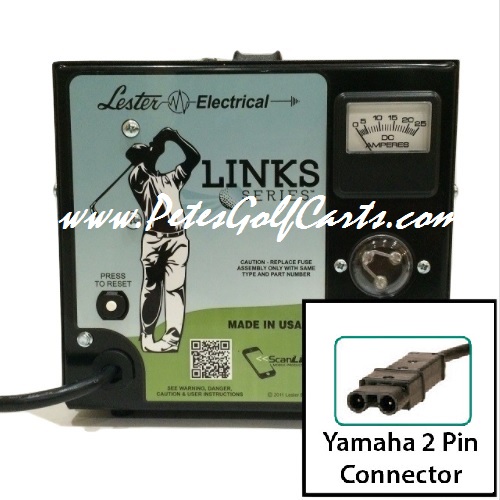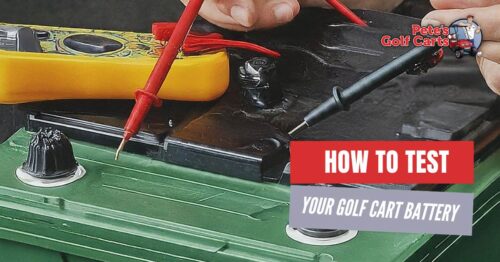This question was asked by a customer of our the other day and Pete wanted to share this information with you as well because it is a question Pete has found himself explaining over and over again over the years.
Question: From Rick in Florida – Over Charging Batteries?
”I have a new links charger and it seems to be over charging the batteries. The batteries were bubbling and the charger was still running. Charging at about 5 amps. 2 hours after I disconnected the charger batteries read 12.94 V Batteries are new Trojan 1275 Any suggestions?”
Answer :
A Transformer style charger
The Lester Electric Golf Cart Battery Charger you purchased is a transformer style charger that is designed to apply amperage and voltage for a length of time that replaces the energy used from last discharge. This is fairly old technology but very effective to charge your golf cart batteries. Depending on the battery chargers output (Amperage), the batteries size (Capacity), and DOD(depth of discharge), all this will determine the amount of time required to fully charge the battery bank in question. In the process as they reach maximum capacity the more electricity that is forced into the batteries the more it excites the electrolyte and gets electrons moving in the battery itself…(That is the boiling sound you hear)
The gurgling sound is common – and okay!
This is common… especially with NEW batteries…. this process actually needs to happen to positively charge and electrify the lead plates and cure the new lead…. any new battery pulled off the line at the manufacture will only test out at about 80% advertised Ah rating because the lead hasn’t been cured (still too soft). Something that is really impossible for the manufacturer to do in house because of the process involved.
It takes 15-20 charging cycles to “cure” the lead plates
It takes on average 15-20 cycles at 50% DOD “Depth of Discharge”, to completely cure the new lead plates in a new lead acid battery and allow the battery to reach full capacity (That will be the advertised Ah rating at the 20hr rate.)
So no worries as the charger is just doing its thing… Trojan batteries actually like to get hit harder ( More Amperage applied) than others thru the bulk phase and finishing phase of a charge cycle because the lead plates are thicker than most competitors.
Add more water during this phase
You will most likely add more water than ever over the period of time we will call breaking in phase. This is from the charger forcing electrons into the lead, once the lead is cured electrons cannot pass thru as easily.
The boiling sound will become quieter
At this point the batteries will not be as excited (loud boiling sounds) when charging/complete charge.
There will (and should) always be a bubbling noise
Make no mistake lead acid batteries will always make noise in the charge process and finishing phase because of the specific chemistry and design that make a lead acid battery. It is also an important part to insure good battery health as well. Without this boiling the lead plates sulfate rapidly and severely hinder battery life per charge and cycle life.
This process helps the battery to charge and function
This process actually helps to clean the lead plates and keep them clean to better react to the electrolyte in the cells to create electricity. AGM and Gel style batteries are even more picky than traditional lead acid batteries because they like more voltage and amperage to complete the same process.
Hopefully this was helpful and insightful to ease your worries about your golf cart batteries and the golf cart battery charger. For more information you can also read our “how to test golf cart batteries” post.
Power On…
Pete
Rick – response
Thanks for your response. So I understand the bubbling and sulfur smell are normal and I should not disconnect the charger. What should the Voltage be when fully charged? Should I charge even when reading about 12.5 volts after 9 holes? – Great service, by the way.
Pete – response
No worries … I have seen 48v systems run as high as 58-60v when charging, but it is normal to see voltages around 50v-52v when sitting static for several days after a fresh charge cycle. Most common size lead acid batteries will be from .6 volts to .8 volts over advertised voltage on battery when fully charged. Always good to re-charge cart at the end of the day, never let it sit 1/2 -3/4 charged. re-charge then store when not in use.
Pete
Pete please help…. Batteries Expelled Acid on Charge
Hi i charged my cart with my new charger. Thanks for the fast shipping but the batteries folded expelled acid do i have to change the settings on the charger my batteries are Trojan t-875, 8 volt, 170 ah @ 20hr, 145ah @ 5hr
Pete – response
No Worries – You should be fine with the factory setting…These golf cart chargers come pre set for lead acid batteries and your Trojan batteries are well within the settings range. It sounds like the batteries were over filled. Always check the level of the electrolyte after batteries are fully charged and only fill each cell about 1/4 – 3/8 inch above the batteries plates… which leaves about equal distance to the bottom of the cell cap tube.
Pete’s Team








